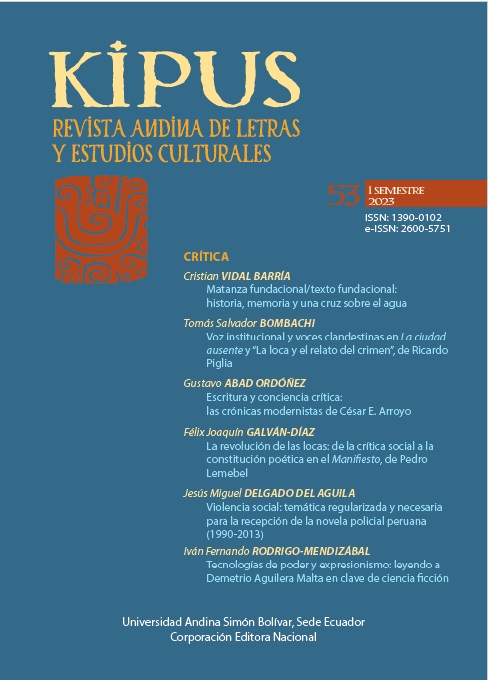Voz institucional y voces clandestinas en La ciudad ausente y “La loca y el relato del crimen”, de Ricardo Piglia
Contenido principal del artículo
Resumen
A partir de la novela La ciudad ausente (1992) y el cuento “La loca y el relato del crimen” (1975), Ricardo Piglia organiza un espacio estructurado por distintas voces: las voces institucionales (el discurso policial, médico y jurídico), las cuales entran en tensión con las voces adyacentes y periféricas (de gauchos, inventores, locas y periodistas). Aquellas voces adquieren una corporalidad en las distintas máquinas de narrar, como la grabadora, el teléfono y el casete. Literatura y medios. El estudio de la voz (una voz que se simula en el texto) en ambas narraciones de Piglia es permeable a distintos discursos filosóficos y psicológicos. ¿Qué sucedería si los flujos de información (lo dicho) no pudiesen ser controlados, codificados y, por ende, reterritorializados, es decir, vueltos a poner en un lugar, rotularlos como, por ejemplo, lícitos o ilícitos? El objetivo del trabajo es analizar las voces presentes en los textos literarios y la dinámica de control, censura y autoridad que las teje, desde donde se propone pensar y trabajar la hipótesis de que Piglia construye a Junior y Renzi, personajes medulares de los textos, como oyentes atentos.
##plugins.themes.bootstrap3.displayStats.downloads##
Detalles del artículo
Sección

Esta obra está bajo una licencia internacional Creative Commons Atribución-NoComercial-CompartirIgual 4.0.
Cómo citar
Referencias
Agamben, Giorgio. 2011. “¿Qué es un dispositivo?”. Revista Sociológica, n.º 73: 249-64.
___. 2017. ¿Qué es la filosofía? Buenos Aires: Adriana Hidalgo Editora.
Barthes, Roland. 1986. Lo obvio y lo obtuso. Imágenes, gestos, voces. Barcelona: Paidós.
Benveniste, Émile. 2014. Últimas lecciones. Buenos Aires: Siglo XXI.
Casarin, Marcelo. 2017. “La escritura de Ricardo Piglia: rastros de una pesquisa”. Anales de Literatura Hispanoamericana 36: 103-9.
Deleuze, Gilles. 2017. “Clase 1. Capitalismo y esquizofrenia. Introducción al esquizoanálisis”. En Derrames. Entre el capitalismo y la esquizofrenia. Buenos Aires: Cactus.
Deleuze, Gilles, y Félix Guattari. 2021. “Les machines désirantes”. En Capitalisme et schizophrénie 1. L´anti-OEdipe. París: Les éditions de minuit.
Dollar, Mladen. 2017. Una voz y nada más. Buenos Aires: Manantial. Ong, Walter J. 1993. “Lo impreso, el espacio y lo concluido”. En Oralidad y escritura. Tecnología de la palabra. Buenos Aires: Fondo de Cultura Económica.
Piglia, Ricardo. 1994. Nombre falso. Buenos Aires: Seix Barral.
___. 2003. La ciudad ausente. Barcelona: Anagrama.
Saítta, Sylvia. 2004. “Ciudades revisitadas”. En Revista de Literaturas Modernas, n.º 34: 135-49.
Vinelli, Elena Elvira. 2011. “Los lectores insomnes: las miradas críticas sobre La ciudad ausente”. En Relato migrante. La transposición de la novela La ciudad ausente de Ricardo Piglia a ópera e historieta. Buenos Aires: Filo Digital.
Walsh, Rodolfo. 2019. “Variaciones en rojo”. En Variaciones en rojo. Buenos Aires: Ediciones La Flor.


